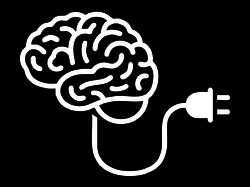I was six years old the first time I saw the future.
My elementary school imported a steady and unusual program of guest speakers. Our assemblies featured a swami, a secret agent and, on this particular day, a wiry young man with a stage full of equipment.
From inside my pint-sized body, the machinery in the auditorium that day seemed huge, a mainframe-sized collection of premium 1970s technology. Our visitor dashed from console to console, leaping thick cables, getting his gear ready. He stopped in front of a big keyboard and then looked up at us. And that’s when the sound started.
“Any sufficiently advanced technology is indistinguishable from magic,” Arthur C. Clarke famously wrote. He wasn’t talking parlor tricks. He referred to technology that so completely transcends our everyday understanding of the world that it is utterly inexplicable. Aristotle, Clarke wrote, would have been at a loss to explain how touching two pieces of metal together could unleash a devastating surge of energy. For all his genius, the philosopher’s understanding of science could not possibly embrace nuclear reaction.
The mind’s eye can’t see around the corner of brain-bending scientific breakthroughs. This is one of the things that make the prophet racket so hard. A single discovery or insight can suddenly make the impossible possible, even easy. The fact that we don’t foresee such changes is an excusable failure of imagination. It’s hard, foolhardy perhaps, to predict that the impossible is within reach.
Less forgivable is what Clarke called “the failure of nerve.” That’s when all the pieces for powerful change are sitting right in front of us, ready and available, and we fail to see their potential. We’re so stuck on the way things have been that we don’t see how they might be rearranged to powerful effect.
Failures of nerve often seem ridiculous after the fact, because the outcome seems so obvious in hindsight. In 1985, a New York Times column predicted a miserable future for laptop computers:
On the whole, people don’t want to lug a computer with them to the beach or on a train to while away hours they would rather spend reading the sports or business section of the newspaper. Somehow, the microcomputer industry has assumed that everyone would love to have a keyboard grafted on as an extension of their fingers. It just is not so.…
Yes, there are a lot of people who would like to be able to work on a computer at home. But would they really want to carry one back from the office with them? It would be much simpler to take home a few floppy disks tucked into an attache case.…
[T]he real future of the laptop computer will remain in the specialized niche markets. Because no matter how inexpensive the machines become, and no matter how sophisticated their software, I still can’t imagine the average user taking one along when going fishing.
The sound started simply enough. A bleep here, then a bloop, a buzz and a beep. But slowly the sounds gathered and folded onto each other to form deepening layers. It’s robot music, I thought. I knew, because Star Wars had arrived in theaters that spring. The auditorium filled with the sound of a hundred R2-D2s chirping in harmony. It was electronic, unnatural, but still… distinctly musical.
At the center of the sound was our visitor, in t-shirt and sneakers, a wild-eyed composer creating a one-man symphony, just him and his machines. He was making the machines sing.
The significance of new combinations tends to escape us. When someone embeds a computer inside a watch, it’s all too natural for us to assume that it will be used like either a computer or a watch. A smartphone on your wrist! A failure of nerve prevents us from imagining the entirely new thing that this combination might represent. The habits of the original technology blind us to the potential opportunities of the new.
Today’s combinations are especially hard to parse because they’re no longer about individual instances of technology. The potential of a smartwatch, for example, hinges not only on the combination of its component parts but on its combination with other smart and dumb objects in our lives.
As we weigh the role of the smartwatch, we have to muster the nerve to imagine: How might it talk to other devices? How can it interact with the physical world? What does it mean to wear data? How might the watch signal identity in the digital world as we move through the physical? How might a gesture or flick of the wrist trigger action around me? What becomes possible if smart watches are on millions of wrists? What are the social implications? What new behaviors will the watch channel and shape? How will it change the way I use other devices? How might it knit them together?
As we begin to embed technology into everything—when anything can be an interface—we can no longer judge each new gadget on its own. The success of any new interface depends on how it controls, reflects, shares, or behaves in a growing community of social devices. We are bridging the gap between digital and physical, one small step at a time. Nerve demands that we take the long view.
He owned us. It’s not easy to hold the attention of 100 grade-schoolers, but after 30 minutes of crafting a live sci-fi soundtrack, he had us completely. A 1970s electronic pied piper.
And then it happened. At the end of his performance, he stepped to the front of the stage. “One day,” he said, “all of you will have a machine that does all this, makes music like this.” Then he pulled out his wallet and held it up. “And it won’t be any bigger than this. It will fit in your pocket.”
A roomful of little first-grade heads exploded. I’ll never forget it: “It will fit in your pocket.” It was the first time I really ached for a specific vision of the future. For me, the future wasn’t rocket cars. It wasn’t living on the moon. It wasn’t even R2-D2. The future was having my own little synthesizer, a computer in my pocket that I could use to make something.
So I waited for the future. At first, I thought it had arrived in 2001 with the iPod. Bam, music in your pocket, just like he said. But that was just a player. It couldn’t make anything. It wasn’t a creative device. It wasn’t until 2007 that I realized that it was the iPhone I was waiting for. Apple’s fabulous device was the first thing to resemble my childhood notions of the future. It was the very first time the future finally got here. And I’ll be damned if the future didn’t fit in my pocket, exactly as promised.
I don’t know who our guest was. I wish I knew his name. His equipment wouldn’t fit in my living room, let alone my pocket. Gordon Moore had posited Moore’s Law only a decade earlier. The Apple II personal computer would hit the market later that summer. And the New York Times was still eight years away from declaring the death of the portable computer. Yet this guy was already sharing his vision for tiny personal computers. Even more remarkable, he had the foresight to imagine them dedicated to creativity and leisure.
I thought about his promise every few months for the next three decades. And now that this stuff is what I do for a living, I think about it even more. I think about it every time I feel a lapse of imagination or nerve, or when I’m tempted to say, “it can’t be done” or “I just don’t see it.” I think back to the robot conductor of 1977, and I’m inspired to look again, deeper this time.
“The only way of discovering the limits of the possible is to venture a little way past them into the impossible,” Clarke wrote. There’s fresh magic minted every day. It’s up to us to have the nerve to see it.






